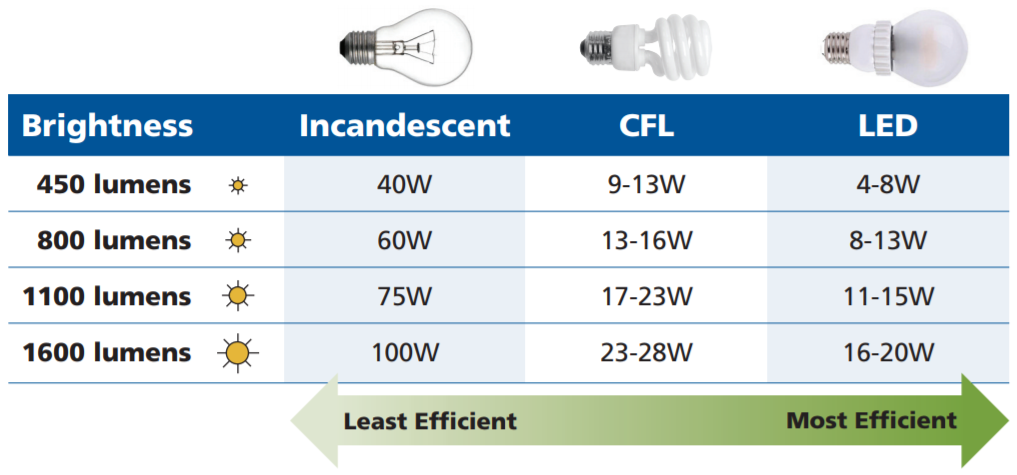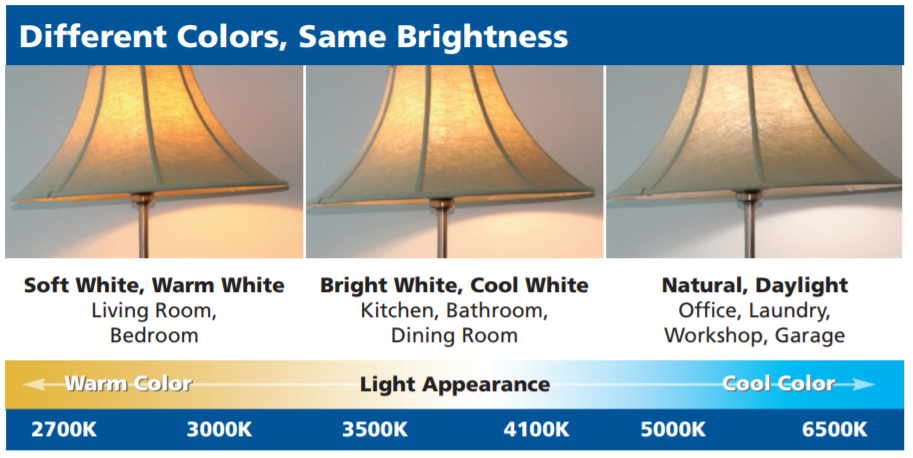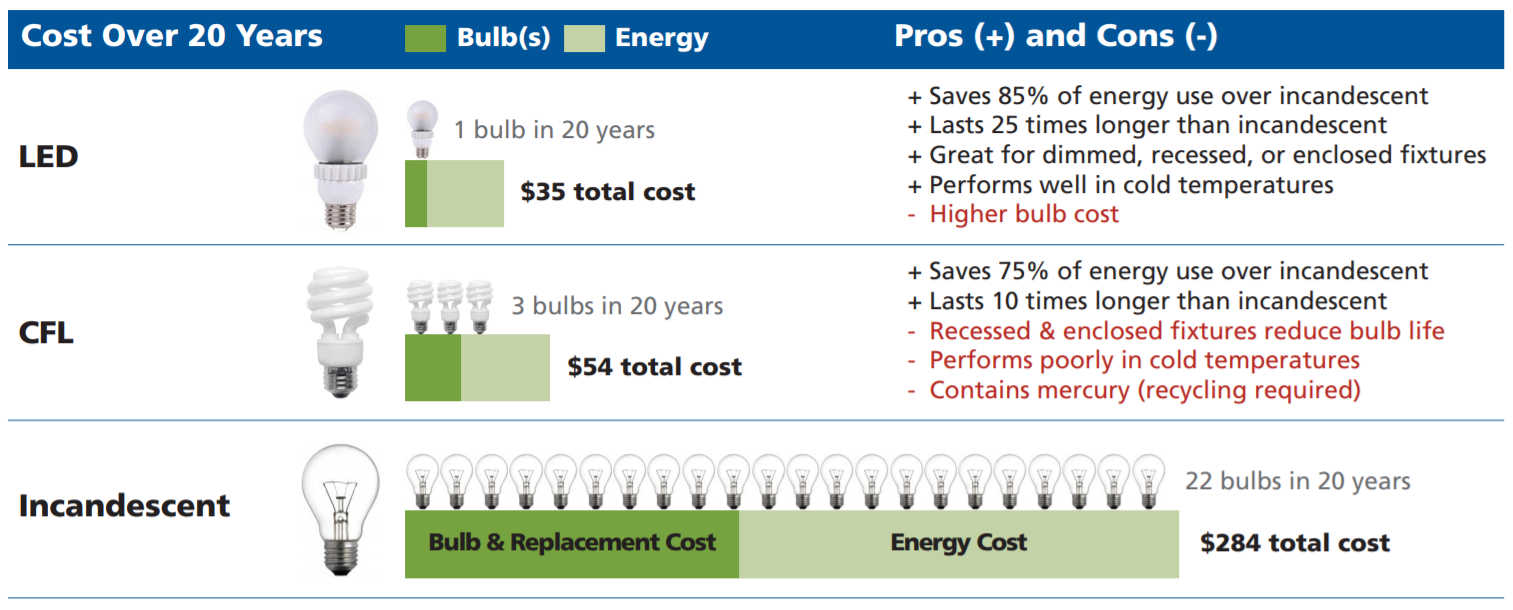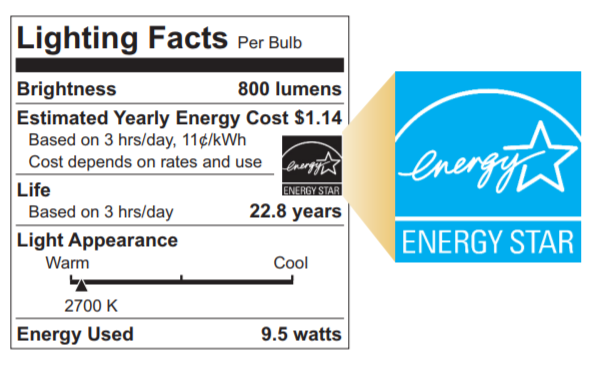Looking for the perfect LED bulb? There’s an app for that!
The Right Light App helps you choose the right energy efficient LED bulb for you, from bulb and fixture types to color and brightness suggestions.
The Right Light App helps you choose the right energy efficient LED bulb for you, from bulb and fixture types to color and brightness suggestions.
STEP 1 - Decide How Much Light You Need
Focus on Brightness. Different amounts of light are needed for different uses. Instead of thinking about light bulbs based solely on the amount of energy they use, focus on their brightness level.
Lumen is the measurement of brightness. Higher lumen bulbs produce brighter light.
Watt (W) is the measure of power consumption. Lower wattage bulbs can lower your electric bills.

If you like your bulb’s current brightness, choose an LED with similar lumens to reduce your energy use. You may also consider a bulb that is less bright to save more.
Note: Lumen output listed on packages may vary. Light bulbs listing anywhere from 800 to 860 lumens are similarly bright, for instance.
STEP 2 - Decide What Color Light You Want
Choose Light Appearance. You’ll be pleased with your new bulb by choosing a light appearance that you like. All of these colors are available for LEDs, and at most brightness levels.

Note: Choose warm or soft white (2700-3000 K) to match the color of incandescent bulbs.
STEP 3 - Think About Costs and Benefits
Compare Types of Light Bulbs. You can think about product, replacement, and energy costs over 20 years for different bulb types. Why 20 years? Because LEDs can last that long. Many incandescent bulbs have been phased out, and CFLs are becoming less popular. The pros and cons below will help you pick a bulb that is right for you, and so will the Right Light App at the bottom.

Note: Cost comparison is based on a 20-year life and takes into account power consumption, hours of use per day, residential electric cost, bulb cost, and replacement cost.
Buying High-Quality Bulbs. The Lighting Facts label on all bulb packaging clearly shows light appearance and brightness. The label also includes the ENERGY STAR® logo when a bulb meets the required certification levels for high efficiency, performance, and reliability.

STEP 4 - Find Bulbs & Get Rebates
There’s an app for that! The Right Light App helps you choose the right energy efficient LED bulb for you, from bulb and fixture types to color and brightness suggestions! Access the app from any device at http://rightlightapp.org.
Get utility rebates. Contact your electric utility to learn about lighting rebates.
LEDs use much less electricity than other bulbs, have extremely long-rated lives, produce very little heat, do not emit UV or infrared, contain no mercury, are resistant to shock and vibration, and can operate effectively in extremely cold environments.
Bring the bulb that you are replacing with you to the store to match the size to be sure that your new bulb will fit in the fixture when you get home. Also, some recessed fixtures have tabs that allow you to adjust how deeply the socket is set – be sure to turn power off to the lights before making any such adjustments.
If you want to buy more efficient bulbs over time to reduce the cost of buying a whole home’s bulbs at once, you can replace bulbs in high use areas first. If you leave porch lights on overnight, these bulbs could be upgraded to LED bulbs immediately – the savings could be significant if you’re using incandescent bulbs presently and they work better in the cold too! Next, look around your home to see which spaces you use the most, and therefore use the lights the most in those areas. Do you like to leave the light on over the kitchen sink most of the evening? Is the dining or living room a favorite hangout for the family in the evenings? Do you work from home and have a desk lamp or office light on much of a working day? If you said yes to any of these, then they would all be great places to changeout first. One of the last places to change are bulbs located where lights are used very few hours and turned on and off frequently (for example, closets).
No, but you can. LED light bulbs do not contain hazardous material and so these bulbs can be placed in the garbage. There are electronics in the base of an LED light bulb (a circuit board), and so you can recycle LED light bulbs at some locations. Use the CERTs Right Light Recycler to find locations near you.
County hazardous waste drop-off sites as well as stores like Home Depot, Ace Hardware, Lowe’s, Batteries Plus. Use the CERTs Right Light Recycler to find locations near you.
Saying that a LED light bulb is a “60W equivalent”, for example, is the manufacturer’s way of most easily describing the brightness of the bulb in terms with which we might be familiar. Many folks can picture the brightness difference between a 60W incandescent and a 100W incandescent. So, the manufacturers are equating the LED bulb’s brightness to an incandescent bulb’s brightness using power (watts) instead of brightness (lumens). Someday, we might see packaging that says 800 lumens and 1600 lumens instead!
Most are between $4 and $8 per bulb. At store locations in Xcel Energy service territory, prices on LED and CFL bulbs reflect the utility rebate, making them less expensive than elsewhere in the state. Find stores in Xcel Energy service territory at Xcel Energy’s website.
Most LEDs are dimmable using most dimmers — be sure to check lighting packaging labels. LEDs dim more fully (nearly the full range of 0-100%) and more smoothly than CFLs (even if the CFL is labeled as dimmable). If your dimmer switch is more than 30 years old and/or gets very hot, you should replace your switch, regardless of what style of bulb you use. Older or incompatible dimmer switches may cause flickering or a dim that is not very smooth dim. Upgrading to a new dimmer switch is easy and inexpensive. Choose a “universal” style and avoid dimmers that are for “incandescent-only.” You can also opt for a dimmer that is specifically for LED, but this is not necessary. Also, pay attention to the maximum wattage specified for the new dimmer switch to be sure it is enough to accommodate the sum of current and future light bulb wattages on that switch.
Only when labeled as such. A non-3-way LED bulb will work in a fixture with a 3-way switch, but only at the highest light output level.
All light bulbs will have their lives shortened by being in enclosed fixtures, including incandescent, CFL, and LEDs. LEDs being the bulbs that produce the least amount of waste heat are the best choice in enclosed fixtures, but be aware they may not last as long as they are rated. Many new LED bulbs specifically say on the packaging whether they are safe for enclosed fixtures.
Early bulb failure is the only danger here, not safety. On the other hand especially incandescent and to a lesser extent CFLs used in a fully enclosed fixture can present a fire hazard as well as early failure. Many fixtures that seem to be fully enclosed are not actually fully enclosed – Inspect closely for ventilation holes often at the top.
More detail: Most CFLs are A-line bulbs. These can be used in a variety of places, but Dept of Energy recommends using CFLs packaged as ellipsoidal reflectors (type-ER) in recessed fixtures. Use reflector (type-R) or parabolic reflector (type-PAR) CFLs for flood and spotlighting.
Yes, LED bulbs work great outside. Unlike CFLs, which take a long time to come on in the cold and can be dimmer or bluish in color, LEDs come on instantly and create the same light level at any temperature.
Unfortunately, sensationalized stories have scared many off from the use of high efficiency lighting. CFLs and LEDs are far safer than incandescent and halogen bulbs. 20% of home fires originate from lighting — typically when a flammable item (fabric, dead bugs, wall or ceiling features, etc.) comes in contact with high temperatures from any bulb or when the filament in a halogen or incandescent bulb breaks and causes a spark that ignites flammable vapors or materials. Halogen bulbs present the highest risk, as they have the highest operating temperature, followed by incandescent, followed by the much lower risk of CFLs. Aside from the extremely rare fire from manufacturing defect (8 total fires reported), LEDs present basically no fire risk. (National Fire Protection Association)
Only time will tell. We have learned a lot why CFL bulbs had shorter lives and the same reasons of using bulbs in fully enclosed fixtures and not being ENERGY STAR labeled are still going to be likely culprits for reduced LED bulb life.
Fluorescent lighting is universal. Look up, and you’ll likely find these familiar tubes lining the ceilings of many buildings. Linear fluorescent lamps (LFLs) have largely reached their maximum energy-saving potential, and they also require recycling.
LED lighting is rapidly evolving and providing an alternative to LFLs. Building owners and facility managers are adopting LED lighting for its long life span, energy efficiency, and controllability.
During our February CERTConference back in 2013 several regions expressed interest in LED Street Lighting. Since that time interest has only grown and there are many local governments starting to move forward with projects – including a few CERT Seed Grant Recipients.
To help ourselves better respond to questions about LED street lighting we began to sift through recent reports to tease out answers to the most common questions we were hearing. Rather than keep that to ourselves, we decided we’d be better off sharing that information with all of you. Here goes!
The first question we were often asked was, “Is there funding for LED Street Lighting Retrofits?” The short answer is, maybe. The longer answer is that some utilities in Minnesota have LED Street Lighting rebates. Your best bet would be to talk directly with your local utility about what rebates they have to support this sort of retrofit. Some local units of government could also bundle a street lighting upgrade into a larger energy efficiency infrastructure improvement project through the State’s Guaranteed Energy Savings Program (or “GESP” for short).
Based on the studies that have been published, and anecdotal reports, one thing to keep in mind though is the savings related information. A recent MN DOT study, described further below, pointed out that the majority of the savings from installed LEDs are really on the maintenance end (or rather, avoided maintenance) rather than energy savings. This is also what we’ve heard from cities that have started to look at their options. Now, this should still be a great selling point – saving labor is probably as important as anything else – but it does mean that looking at energy savings figures alone will not likely sell the project.
An LED street lighting forum was hosted at the League of Minnesota Cities Annual Conference on June 19th, where a packed room of 40 people learned first-hand from a tremendously knowledgeable line-up of speakers from across Minnesota.
Is your city in the dark about LED street lighting retrofits? Learn how the technology works, as well as the benefits to your city’s operational budget. See presentations below from city representatives about their experiences and lessons learned, and get tips for picking the right kind of light and selecting a lighting contractor for your project.
Presentations:
LED holiday lights
For many Minnesotans, the house, porch, shrubs and trees are donned with holiday lights. Depending on one’s holiday lighting enthusiasm, a home can save between $10 to $250 each holiday season by switching to LED holiday lighting.
This is because, according to the Department of Energy, LED holiday lights save up to 90% of the energy used by traditional incandescent holiday lights. LEDs are also safer, sturdier, longer lasting, and easier to install.
Fill your stocking with energy savings: For every old holiday lighting string recycled and replaced with more efficient LEDholiday lighting, 19 kilowatt-hours of electricity are saved over the course of the holiday season. This is the same amount of energy as a common CFL household light bulb would use if left on for 24 hours a day for 2 months straight!
ENERGY STAR is the way to go: When shopping for new holiday lights, look for the ENERGY STAR® label to ensure that the product meets strict federal energy efficiency guidelines. ENERGYSTAR-qualified lighting, as well as appliances and electronics, use less energy than their older, inefficient counterparts. ENERGYSTAR-qualified LED decorative lights are an economical choice because they use 75 percent less power than conventional lights and they can last up to 10 times longer.
Other advantages of LEDs include:
Learn more:
To use: Simply choose a lighting material to get started (and provide your location if it is not done automatically).
